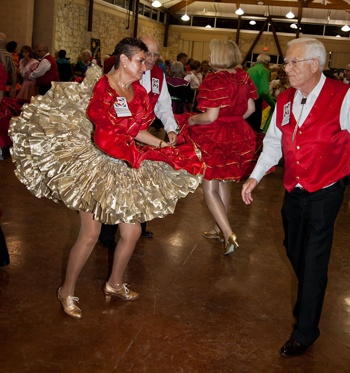Modern square dancing evolved from a melting pot of folk cultures and traditions. Immigrants who settled in the New World brought their French quadrilles, English reels, Irish jigs and many other dances. From there, historical accounts vary. According to The Complete Book of Square Dancing [and Round Dancing] by the late Betty Casey, square dancing melds three types of dances: quadrilles, danced by four couples in a square formation; contras, danced by couples in facing lines to patterns called by a prompter; and the Appalachian, or Kentucky, Running Set, danced in one large circle in designs led by a caller.
In Texas, early settlers enjoyed few forms of entertainment on the isolated frontier. So whenever news came of an upcoming dance, they’d often travel for miles to attend one. Dances brought people together to socialize, meet potential mates and have some fun. Understandably, though, few folks had access to formal dance lessons. No problem. Callers at square dances sang out basic moves, “like swing your partner and promenade all,” ensuring that everyone could keep in step.
Before 1920, interest in square dancing waned. Enter auto king Henry Ford, who loathed the era’s popular jazz but adored old-fashioned dances like the schottische, minuet and square dancing. “The old dances were social,” Ford wrote in his 1926 autobiography Today and Tomorrow. “The modern dances are not. The same two people may dance together all evening, but the old dances gave one a dozen partners in an evening.” In 1923, he bought the Wayside Inn in Sudbury, Massachusetts, where he met dancing master Benjamin Lovett. The two partnered for more than 20 years to teach old-time American dances.
Throughout the 1920s, Ford and his wife, Clara, actively crusaded to bring back old-fashioned dancing across America. In 1926, they published Good Morning: After a Sleep of Twenty-five Years, Old-fashioned Dancing is Being Revived. The instruction book described the styles, steps and calls of Ford’s beloved dances.
In 1937, he built Lovett Hall at the Edison Institute (now known as the Henry Ford Museum and Greenfield Village) in Dearborn, Michigan, where he and Lovett hosted regular dances. Ford even sponsored radio shows, including “Early American Dance Music” in the 1940s with music performed by the Henry Ford Old Time Dance Orchestra, featuring a dulcimer, cymbal, violin and bass violin.
Inspired by the Fords’ Good Morning book, Lloyd “Pappy” Shaw, an innovative educator and high school superintendent from Colorado, traveled cross-country and documented folk dances. In 1939, he published Cowboy Dances, a detailed compilation of folk dances, calls and steps. His high school exhibition team, the Cheyenne Mountain Dancers, toured the United States in the 1930s and ’40s. Square dancing caught on again like wildfire.
For two years, the square dance reigned as our national dance after President Ronald Reagan signed a temporary joint resolution passed by Congress in 1982. For the designation to stick, however, two-thirds of the states had to endorse it. So far, that still hasn’t happened. To date, 31 states, including Texas in 1991, have made the square dance their official folk dance.
——————–
Sheryl Smith-Rodgers, frequent contributor

